Keio Law School Report: Trade War Between Japan and South Korea
VerifiedAdded on 2023/01/18
|10
|2989
|80
Report
AI Summary
This report examines the trade war between Japan and South Korea, focusing on the political history of both nations and their evolving trade relations. It analyzes the roles of the World Trade Organization (WTO) in resolving disputes, including the dispute resolution procedures and timelines. The report details the positions of both Japan and South Korea, highlighting the arguments and measures taken by each country, such as export restrictions on critical materials and the comfort women issue. Furthermore, it explores the implications of these trade disputes on the semiconductor industry and overall economic relations. The report concludes with a synthesis of the issues and potential solutions, providing a comprehensive overview of the conflict and its complexities.
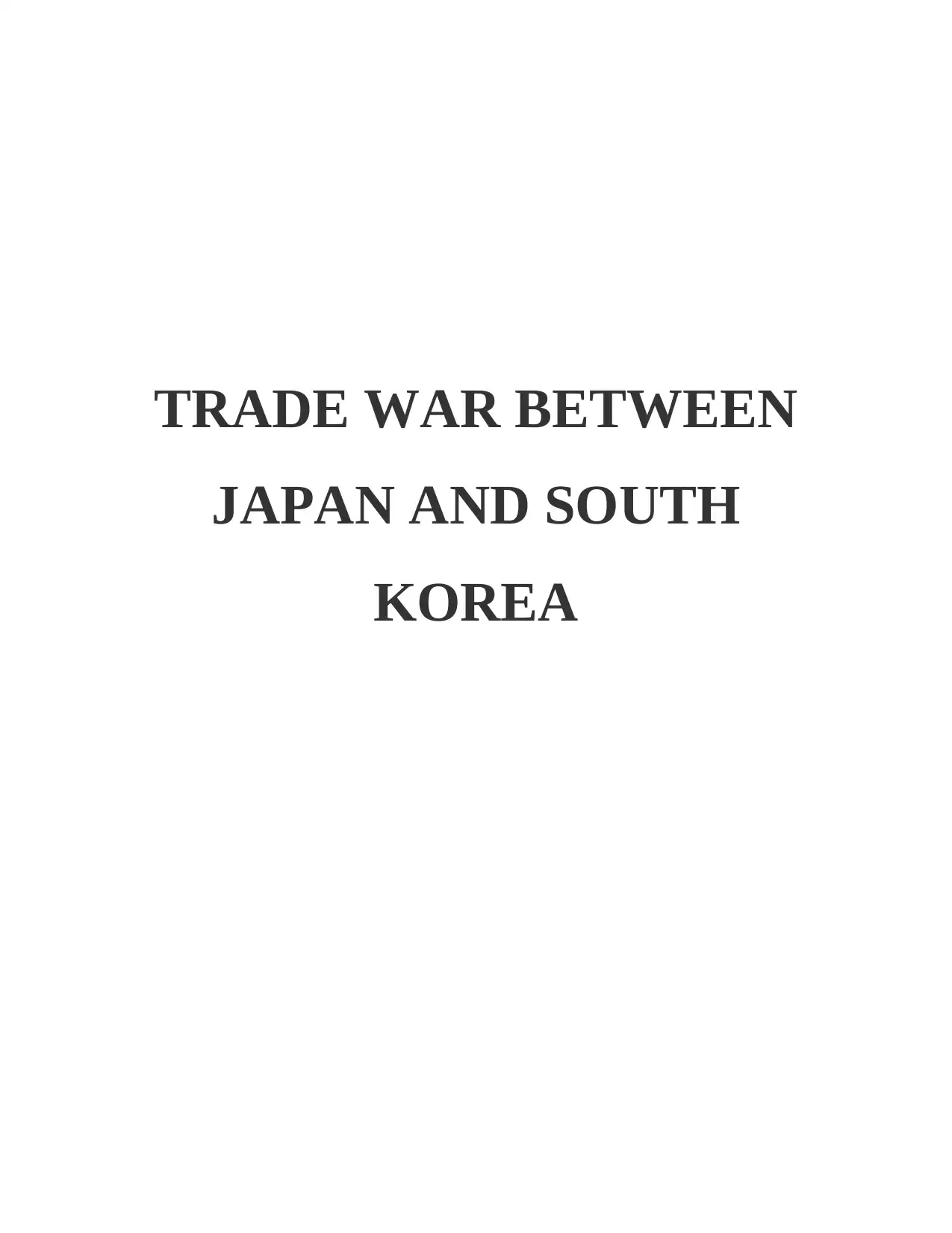
TRADE WAR BETWEEN
JAPAN AND SOUTH
KOREA
JAPAN AND SOUTH
KOREA
Paraphrase This Document
Need a fresh take? Get an instant paraphrase of this document with our AI Paraphraser
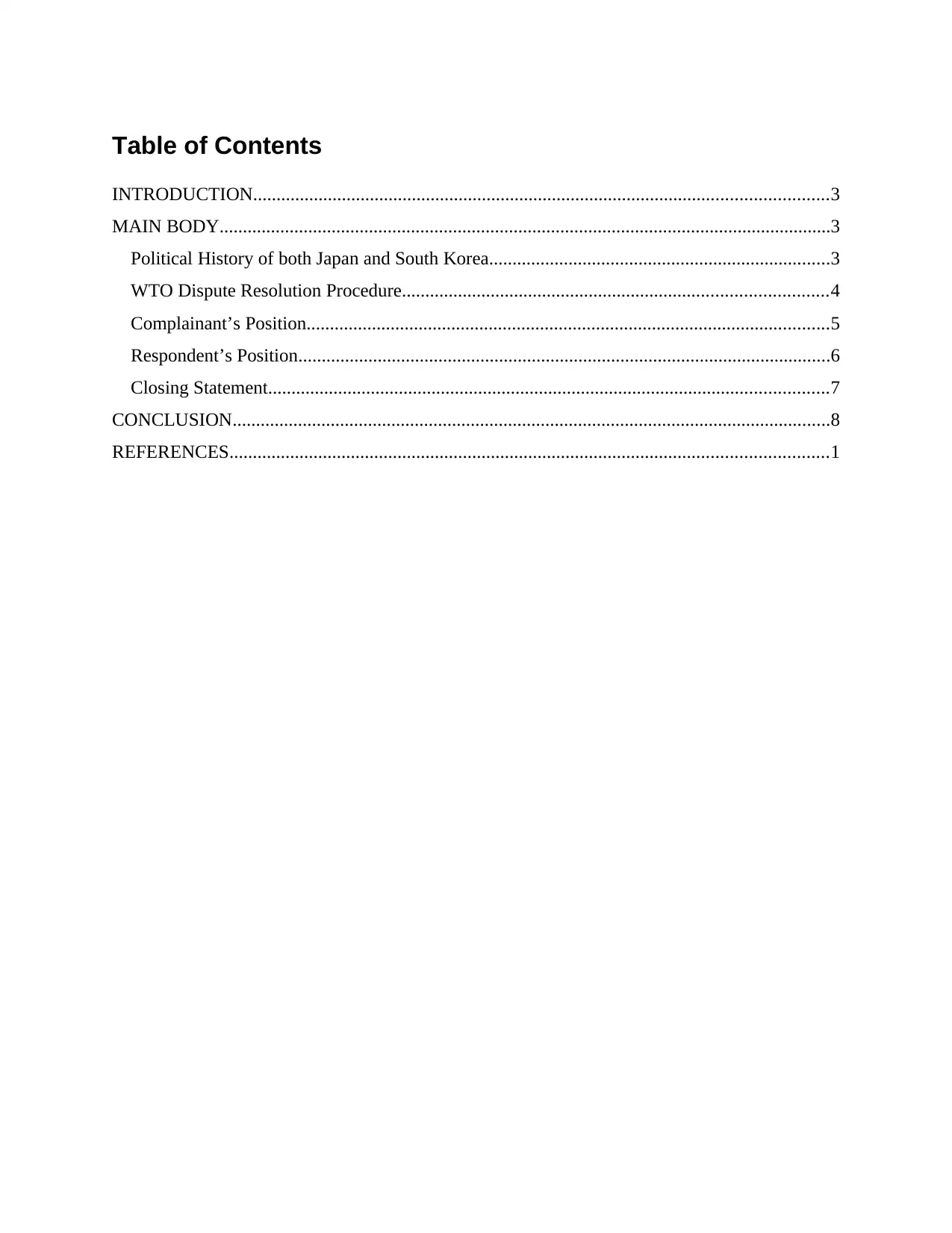
Table of Contents
INTRODUCTION...........................................................................................................................3
MAIN BODY...................................................................................................................................3
Political History of both Japan and South Korea.........................................................................3
WTO Dispute Resolution Procedure...........................................................................................4
Complainant’s Position................................................................................................................5
Respondent’s Position..................................................................................................................6
Closing Statement........................................................................................................................7
CONCLUSION................................................................................................................................8
REFERENCES................................................................................................................................1
INTRODUCTION...........................................................................................................................3
MAIN BODY...................................................................................................................................3
Political History of both Japan and South Korea.........................................................................3
WTO Dispute Resolution Procedure...........................................................................................4
Complainant’s Position................................................................................................................5
Respondent’s Position..................................................................................................................6
Closing Statement........................................................................................................................7
CONCLUSION................................................................................................................................8
REFERENCES................................................................................................................................1
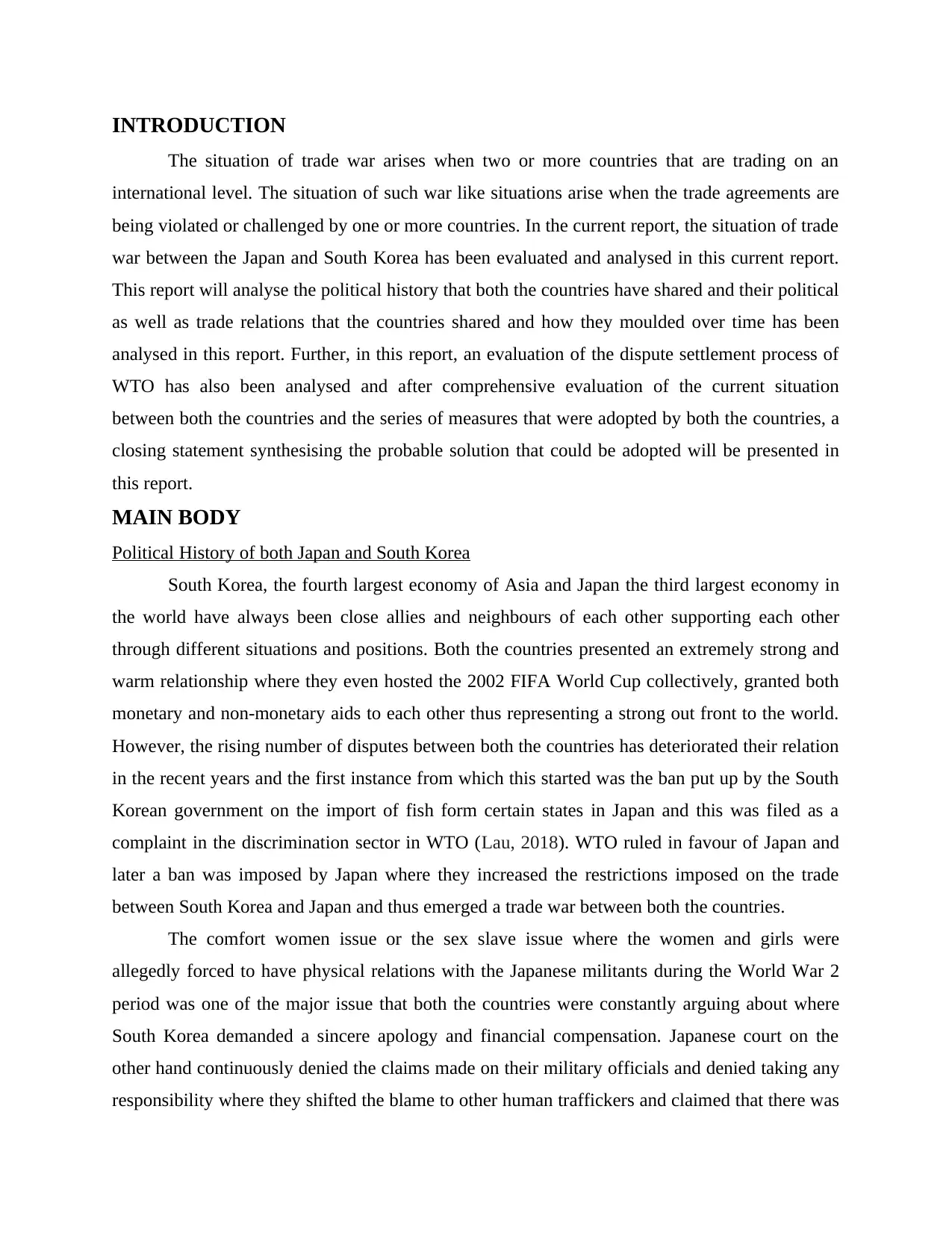
INTRODUCTION
The situation of trade war arises when two or more countries that are trading on an
international level. The situation of such war like situations arise when the trade agreements are
being violated or challenged by one or more countries. In the current report, the situation of trade
war between the Japan and South Korea has been evaluated and analysed in this current report.
This report will analyse the political history that both the countries have shared and their political
as well as trade relations that the countries shared and how they moulded over time has been
analysed in this report. Further, in this report, an evaluation of the dispute settlement process of
WTO has also been analysed and after comprehensive evaluation of the current situation
between both the countries and the series of measures that were adopted by both the countries, a
closing statement synthesising the probable solution that could be adopted will be presented in
this report.
MAIN BODY
Political History of both Japan and South Korea
South Korea, the fourth largest economy of Asia and Japan the third largest economy in
the world have always been close allies and neighbours of each other supporting each other
through different situations and positions. Both the countries presented an extremely strong and
warm relationship where they even hosted the 2002 FIFA World Cup collectively, granted both
monetary and non-monetary aids to each other thus representing a strong out front to the world.
However, the rising number of disputes between both the countries has deteriorated their relation
in the recent years and the first instance from which this started was the ban put up by the South
Korean government on the import of fish form certain states in Japan and this was filed as a
complaint in the discrimination sector in WTO (Lau, 2018). WTO ruled in favour of Japan and
later a ban was imposed by Japan where they increased the restrictions imposed on the trade
between South Korea and Japan and thus emerged a trade war between both the countries.
The comfort women issue or the sex slave issue where the women and girls were
allegedly forced to have physical relations with the Japanese militants during the World War 2
period was one of the major issue that both the countries were constantly arguing about where
South Korea demanded a sincere apology and financial compensation. Japanese court on the
other hand continuously denied the claims made on their military officials and denied taking any
responsibility where they shifted the blame to other human traffickers and claimed that there was
The situation of trade war arises when two or more countries that are trading on an
international level. The situation of such war like situations arise when the trade agreements are
being violated or challenged by one or more countries. In the current report, the situation of trade
war between the Japan and South Korea has been evaluated and analysed in this current report.
This report will analyse the political history that both the countries have shared and their political
as well as trade relations that the countries shared and how they moulded over time has been
analysed in this report. Further, in this report, an evaluation of the dispute settlement process of
WTO has also been analysed and after comprehensive evaluation of the current situation
between both the countries and the series of measures that were adopted by both the countries, a
closing statement synthesising the probable solution that could be adopted will be presented in
this report.
MAIN BODY
Political History of both Japan and South Korea
South Korea, the fourth largest economy of Asia and Japan the third largest economy in
the world have always been close allies and neighbours of each other supporting each other
through different situations and positions. Both the countries presented an extremely strong and
warm relationship where they even hosted the 2002 FIFA World Cup collectively, granted both
monetary and non-monetary aids to each other thus representing a strong out front to the world.
However, the rising number of disputes between both the countries has deteriorated their relation
in the recent years and the first instance from which this started was the ban put up by the South
Korean government on the import of fish form certain states in Japan and this was filed as a
complaint in the discrimination sector in WTO (Lau, 2018). WTO ruled in favour of Japan and
later a ban was imposed by Japan where they increased the restrictions imposed on the trade
between South Korea and Japan and thus emerged a trade war between both the countries.
The comfort women issue or the sex slave issue where the women and girls were
allegedly forced to have physical relations with the Japanese militants during the World War 2
period was one of the major issue that both the countries were constantly arguing about where
South Korea demanded a sincere apology and financial compensation. Japanese court on the
other hand continuously denied the claims made on their military officials and denied taking any
responsibility where they shifted the blame to other human traffickers and claimed that there was
⊘ This is a preview!⊘
Do you want full access?
Subscribe today to unlock all pages.

Trusted by 1+ million students worldwide
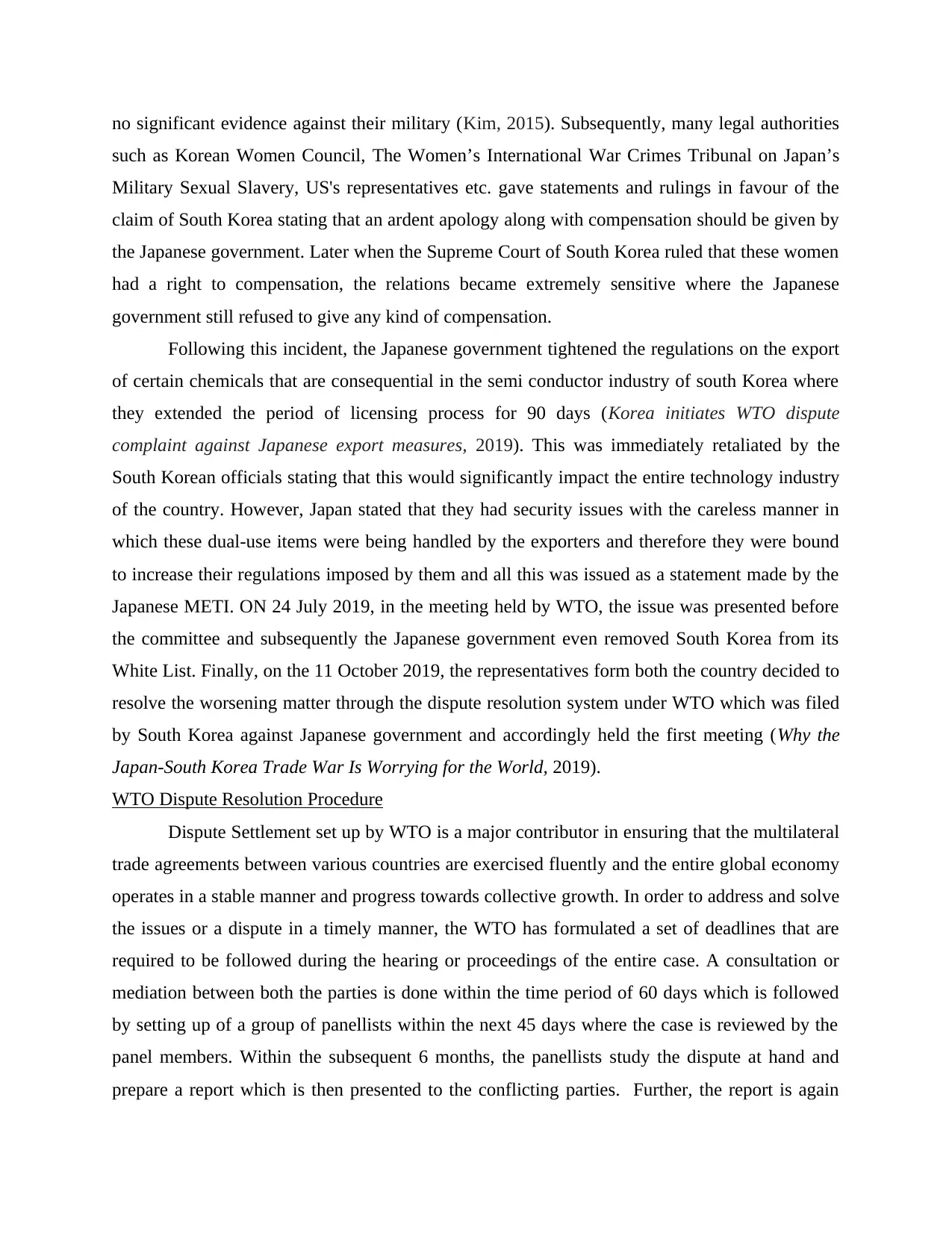
no significant evidence against their military (Kim, 2015). Subsequently, many legal authorities
such as Korean Women Council, The Women’s International War Crimes Tribunal on Japan’s
Military Sexual Slavery, US's representatives etc. gave statements and rulings in favour of the
claim of South Korea stating that an ardent apology along with compensation should be given by
the Japanese government. Later when the Supreme Court of South Korea ruled that these women
had a right to compensation, the relations became extremely sensitive where the Japanese
government still refused to give any kind of compensation.
Following this incident, the Japanese government tightened the regulations on the export
of certain chemicals that are consequential in the semi conductor industry of south Korea where
they extended the period of licensing process for 90 days (Korea initiates WTO dispute
complaint against Japanese export measures, 2019). This was immediately retaliated by the
South Korean officials stating that this would significantly impact the entire technology industry
of the country. However, Japan stated that they had security issues with the careless manner in
which these dual-use items were being handled by the exporters and therefore they were bound
to increase their regulations imposed by them and all this was issued as a statement made by the
Japanese METI. ON 24 July 2019, in the meeting held by WTO, the issue was presented before
the committee and subsequently the Japanese government even removed South Korea from its
White List. Finally, on the 11 October 2019, the representatives form both the country decided to
resolve the worsening matter through the dispute resolution system under WTO which was filed
by South Korea against Japanese government and accordingly held the first meeting (Why the
Japan-South Korea Trade War Is Worrying for the World, 2019).
WTO Dispute Resolution Procedure
Dispute Settlement set up by WTO is a major contributor in ensuring that the multilateral
trade agreements between various countries are exercised fluently and the entire global economy
operates in a stable manner and progress towards collective growth. In order to address and solve
the issues or a dispute in a timely manner, the WTO has formulated a set of deadlines that are
required to be followed during the hearing or proceedings of the entire case. A consultation or
mediation between both the parties is done within the time period of 60 days which is followed
by setting up of a group of panellists within the next 45 days where the case is reviewed by the
panel members. Within the subsequent 6 months, the panellists study the dispute at hand and
prepare a report which is then presented to the conflicting parties. Further, the report is again
such as Korean Women Council, The Women’s International War Crimes Tribunal on Japan’s
Military Sexual Slavery, US's representatives etc. gave statements and rulings in favour of the
claim of South Korea stating that an ardent apology along with compensation should be given by
the Japanese government. Later when the Supreme Court of South Korea ruled that these women
had a right to compensation, the relations became extremely sensitive where the Japanese
government still refused to give any kind of compensation.
Following this incident, the Japanese government tightened the regulations on the export
of certain chemicals that are consequential in the semi conductor industry of south Korea where
they extended the period of licensing process for 90 days (Korea initiates WTO dispute
complaint against Japanese export measures, 2019). This was immediately retaliated by the
South Korean officials stating that this would significantly impact the entire technology industry
of the country. However, Japan stated that they had security issues with the careless manner in
which these dual-use items were being handled by the exporters and therefore they were bound
to increase their regulations imposed by them and all this was issued as a statement made by the
Japanese METI. ON 24 July 2019, in the meeting held by WTO, the issue was presented before
the committee and subsequently the Japanese government even removed South Korea from its
White List. Finally, on the 11 October 2019, the representatives form both the country decided to
resolve the worsening matter through the dispute resolution system under WTO which was filed
by South Korea against Japanese government and accordingly held the first meeting (Why the
Japan-South Korea Trade War Is Worrying for the World, 2019).
WTO Dispute Resolution Procedure
Dispute Settlement set up by WTO is a major contributor in ensuring that the multilateral
trade agreements between various countries are exercised fluently and the entire global economy
operates in a stable manner and progress towards collective growth. In order to address and solve
the issues or a dispute in a timely manner, the WTO has formulated a set of deadlines that are
required to be followed during the hearing or proceedings of the entire case. A consultation or
mediation between both the parties is done within the time period of 60 days which is followed
by setting up of a group of panellists within the next 45 days where the case is reviewed by the
panel members. Within the subsequent 6 months, the panellists study the dispute at hand and
prepare a report which is then presented to the conflicting parties. Further, the report is again
Paraphrase This Document
Need a fresh take? Get an instant paraphrase of this document with our AI Paraphraser
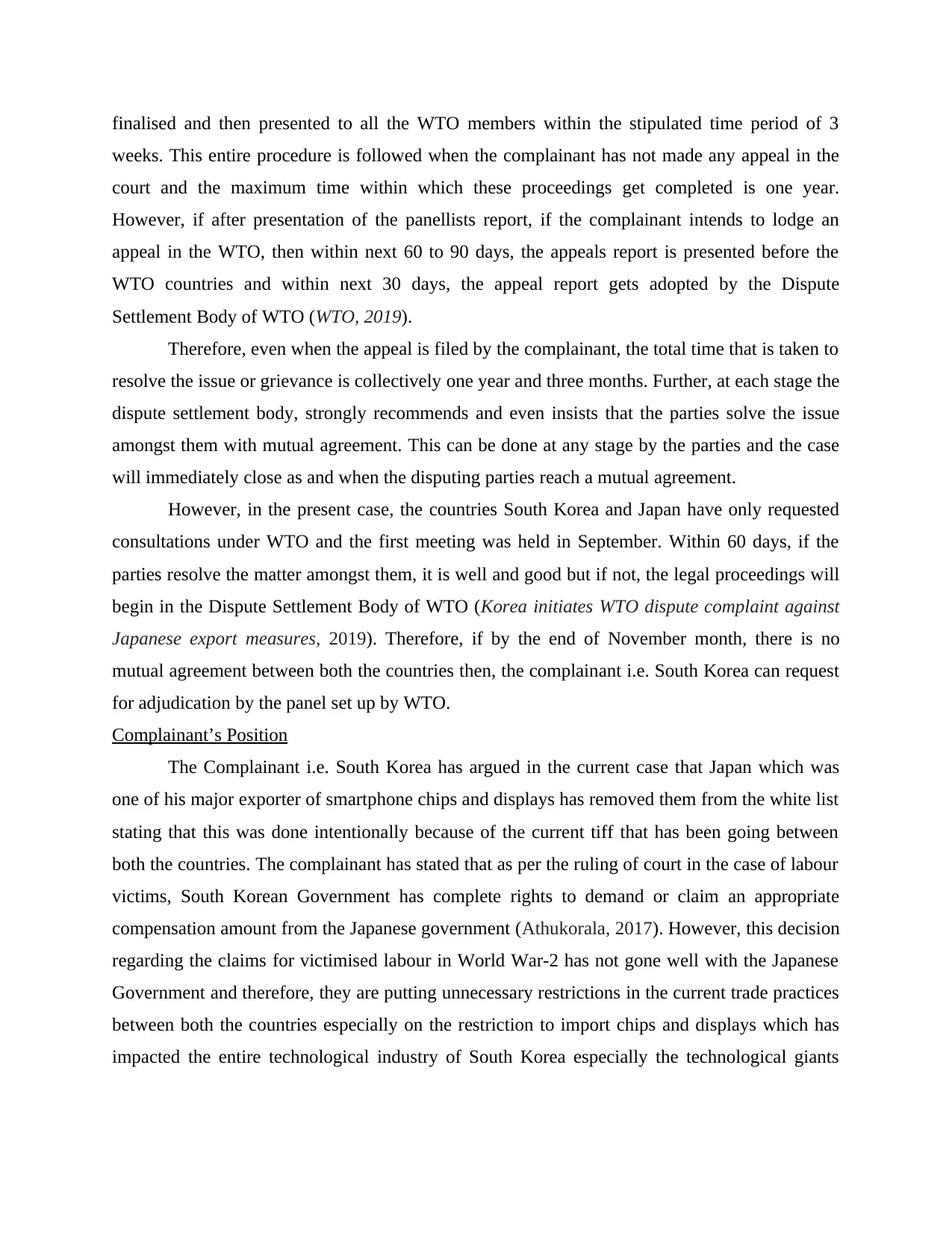
finalised and then presented to all the WTO members within the stipulated time period of 3
weeks. This entire procedure is followed when the complainant has not made any appeal in the
court and the maximum time within which these proceedings get completed is one year.
However, if after presentation of the panellists report, if the complainant intends to lodge an
appeal in the WTO, then within next 60 to 90 days, the appeals report is presented before the
WTO countries and within next 30 days, the appeal report gets adopted by the Dispute
Settlement Body of WTO (WTO, 2019).
Therefore, even when the appeal is filed by the complainant, the total time that is taken to
resolve the issue or grievance is collectively one year and three months. Further, at each stage the
dispute settlement body, strongly recommends and even insists that the parties solve the issue
amongst them with mutual agreement. This can be done at any stage by the parties and the case
will immediately close as and when the disputing parties reach a mutual agreement.
However, in the present case, the countries South Korea and Japan have only requested
consultations under WTO and the first meeting was held in September. Within 60 days, if the
parties resolve the matter amongst them, it is well and good but if not, the legal proceedings will
begin in the Dispute Settlement Body of WTO (Korea initiates WTO dispute complaint against
Japanese export measures, 2019). Therefore, if by the end of November month, there is no
mutual agreement between both the countries then, the complainant i.e. South Korea can request
for adjudication by the panel set up by WTO.
Complainant’s Position
The Complainant i.e. South Korea has argued in the current case that Japan which was
one of his major exporter of smartphone chips and displays has removed them from the white list
stating that this was done intentionally because of the current tiff that has been going between
both the countries. The complainant has stated that as per the ruling of court in the case of labour
victims, South Korean Government has complete rights to demand or claim an appropriate
compensation amount from the Japanese government (Athukorala, 2017). However, this decision
regarding the claims for victimised labour in World War-2 has not gone well with the Japanese
Government and therefore, they are putting unnecessary restrictions in the current trade practices
between both the countries especially on the restriction to import chips and displays which has
impacted the entire technological industry of South Korea especially the technological giants
weeks. This entire procedure is followed when the complainant has not made any appeal in the
court and the maximum time within which these proceedings get completed is one year.
However, if after presentation of the panellists report, if the complainant intends to lodge an
appeal in the WTO, then within next 60 to 90 days, the appeals report is presented before the
WTO countries and within next 30 days, the appeal report gets adopted by the Dispute
Settlement Body of WTO (WTO, 2019).
Therefore, even when the appeal is filed by the complainant, the total time that is taken to
resolve the issue or grievance is collectively one year and three months. Further, at each stage the
dispute settlement body, strongly recommends and even insists that the parties solve the issue
amongst them with mutual agreement. This can be done at any stage by the parties and the case
will immediately close as and when the disputing parties reach a mutual agreement.
However, in the present case, the countries South Korea and Japan have only requested
consultations under WTO and the first meeting was held in September. Within 60 days, if the
parties resolve the matter amongst them, it is well and good but if not, the legal proceedings will
begin in the Dispute Settlement Body of WTO (Korea initiates WTO dispute complaint against
Japanese export measures, 2019). Therefore, if by the end of November month, there is no
mutual agreement between both the countries then, the complainant i.e. South Korea can request
for adjudication by the panel set up by WTO.
Complainant’s Position
The Complainant i.e. South Korea has argued in the current case that Japan which was
one of his major exporter of smartphone chips and displays has removed them from the white list
stating that this was done intentionally because of the current tiff that has been going between
both the countries. The complainant has stated that as per the ruling of court in the case of labour
victims, South Korean Government has complete rights to demand or claim an appropriate
compensation amount from the Japanese government (Athukorala, 2017). However, this decision
regarding the claims for victimised labour in World War-2 has not gone well with the Japanese
Government and therefore, they are putting unnecessary restrictions in the current trade practices
between both the countries especially on the restriction to import chips and displays which has
impacted the entire technological industry of South Korea especially the technological giants
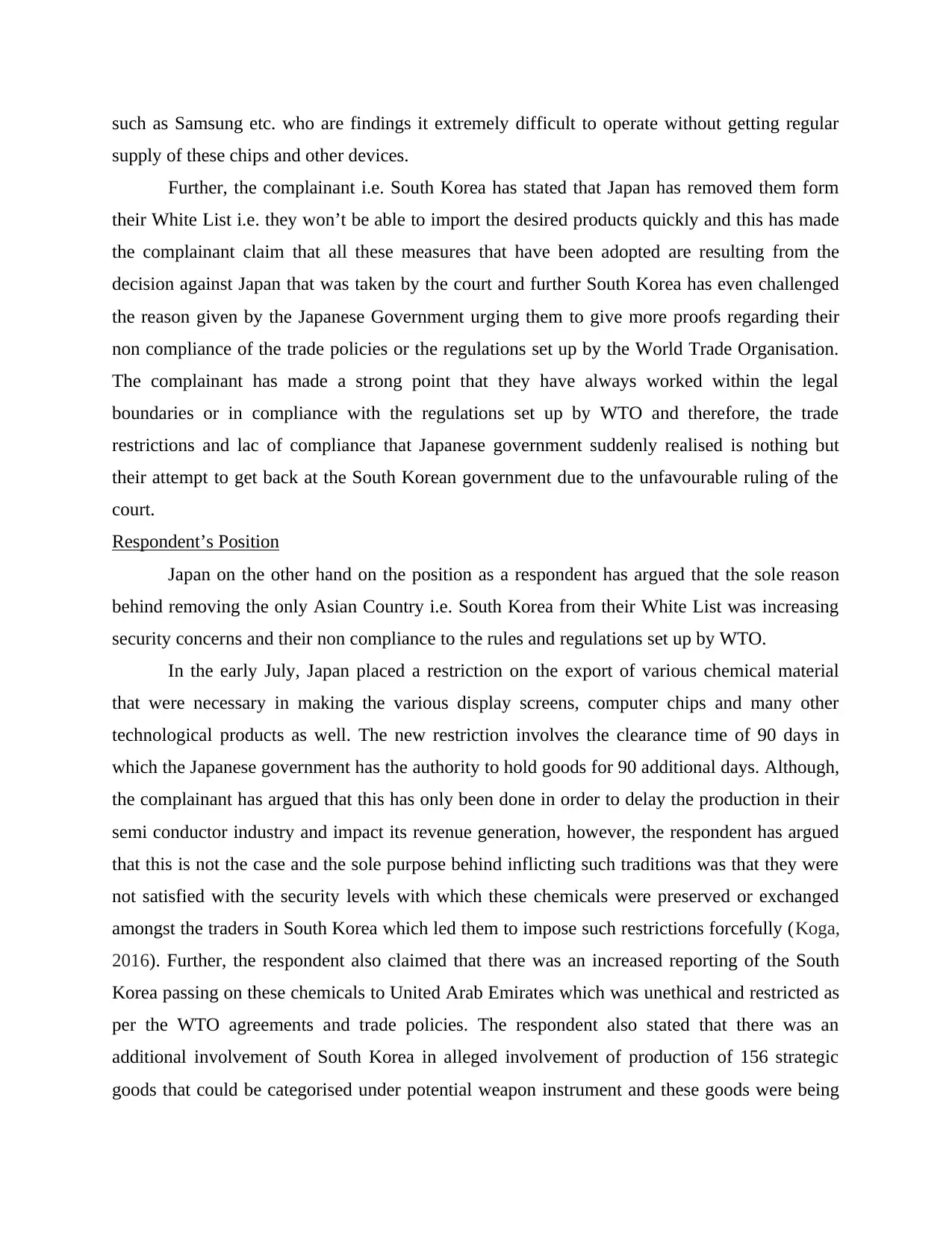
such as Samsung etc. who are findings it extremely difficult to operate without getting regular
supply of these chips and other devices.
Further, the complainant i.e. South Korea has stated that Japan has removed them form
their White List i.e. they won’t be able to import the desired products quickly and this has made
the complainant claim that all these measures that have been adopted are resulting from the
decision against Japan that was taken by the court and further South Korea has even challenged
the reason given by the Japanese Government urging them to give more proofs regarding their
non compliance of the trade policies or the regulations set up by the World Trade Organisation.
The complainant has made a strong point that they have always worked within the legal
boundaries or in compliance with the regulations set up by WTO and therefore, the trade
restrictions and lac of compliance that Japanese government suddenly realised is nothing but
their attempt to get back at the South Korean government due to the unfavourable ruling of the
court.
Respondent’s Position
Japan on the other hand on the position as a respondent has argued that the sole reason
behind removing the only Asian Country i.e. South Korea from their White List was increasing
security concerns and their non compliance to the rules and regulations set up by WTO.
In the early July, Japan placed a restriction on the export of various chemical material
that were necessary in making the various display screens, computer chips and many other
technological products as well. The new restriction involves the clearance time of 90 days in
which the Japanese government has the authority to hold goods for 90 additional days. Although,
the complainant has argued that this has only been done in order to delay the production in their
semi conductor industry and impact its revenue generation, however, the respondent has argued
that this is not the case and the sole purpose behind inflicting such traditions was that they were
not satisfied with the security levels with which these chemicals were preserved or exchanged
amongst the traders in South Korea which led them to impose such restrictions forcefully (Koga,
2016). Further, the respondent also claimed that there was an increased reporting of the South
Korea passing on these chemicals to United Arab Emirates which was unethical and restricted as
per the WTO agreements and trade policies. The respondent also stated that there was an
additional involvement of South Korea in alleged involvement of production of 156 strategic
goods that could be categorised under potential weapon instrument and these goods were being
supply of these chips and other devices.
Further, the complainant i.e. South Korea has stated that Japan has removed them form
their White List i.e. they won’t be able to import the desired products quickly and this has made
the complainant claim that all these measures that have been adopted are resulting from the
decision against Japan that was taken by the court and further South Korea has even challenged
the reason given by the Japanese Government urging them to give more proofs regarding their
non compliance of the trade policies or the regulations set up by the World Trade Organisation.
The complainant has made a strong point that they have always worked within the legal
boundaries or in compliance with the regulations set up by WTO and therefore, the trade
restrictions and lac of compliance that Japanese government suddenly realised is nothing but
their attempt to get back at the South Korean government due to the unfavourable ruling of the
court.
Respondent’s Position
Japan on the other hand on the position as a respondent has argued that the sole reason
behind removing the only Asian Country i.e. South Korea from their White List was increasing
security concerns and their non compliance to the rules and regulations set up by WTO.
In the early July, Japan placed a restriction on the export of various chemical material
that were necessary in making the various display screens, computer chips and many other
technological products as well. The new restriction involves the clearance time of 90 days in
which the Japanese government has the authority to hold goods for 90 additional days. Although,
the complainant has argued that this has only been done in order to delay the production in their
semi conductor industry and impact its revenue generation, however, the respondent has argued
that this is not the case and the sole purpose behind inflicting such traditions was that they were
not satisfied with the security levels with which these chemicals were preserved or exchanged
amongst the traders in South Korea which led them to impose such restrictions forcefully (Koga,
2016). Further, the respondent also claimed that there was an increased reporting of the South
Korea passing on these chemicals to United Arab Emirates which was unethical and restricted as
per the WTO agreements and trade policies. The respondent also stated that there was an
additional involvement of South Korea in alleged involvement of production of 156 strategic
goods that could be categorised under potential weapon instrument and these goods were being
⊘ This is a preview!⊘
Do you want full access?
Subscribe today to unlock all pages.

Trusted by 1+ million students worldwide
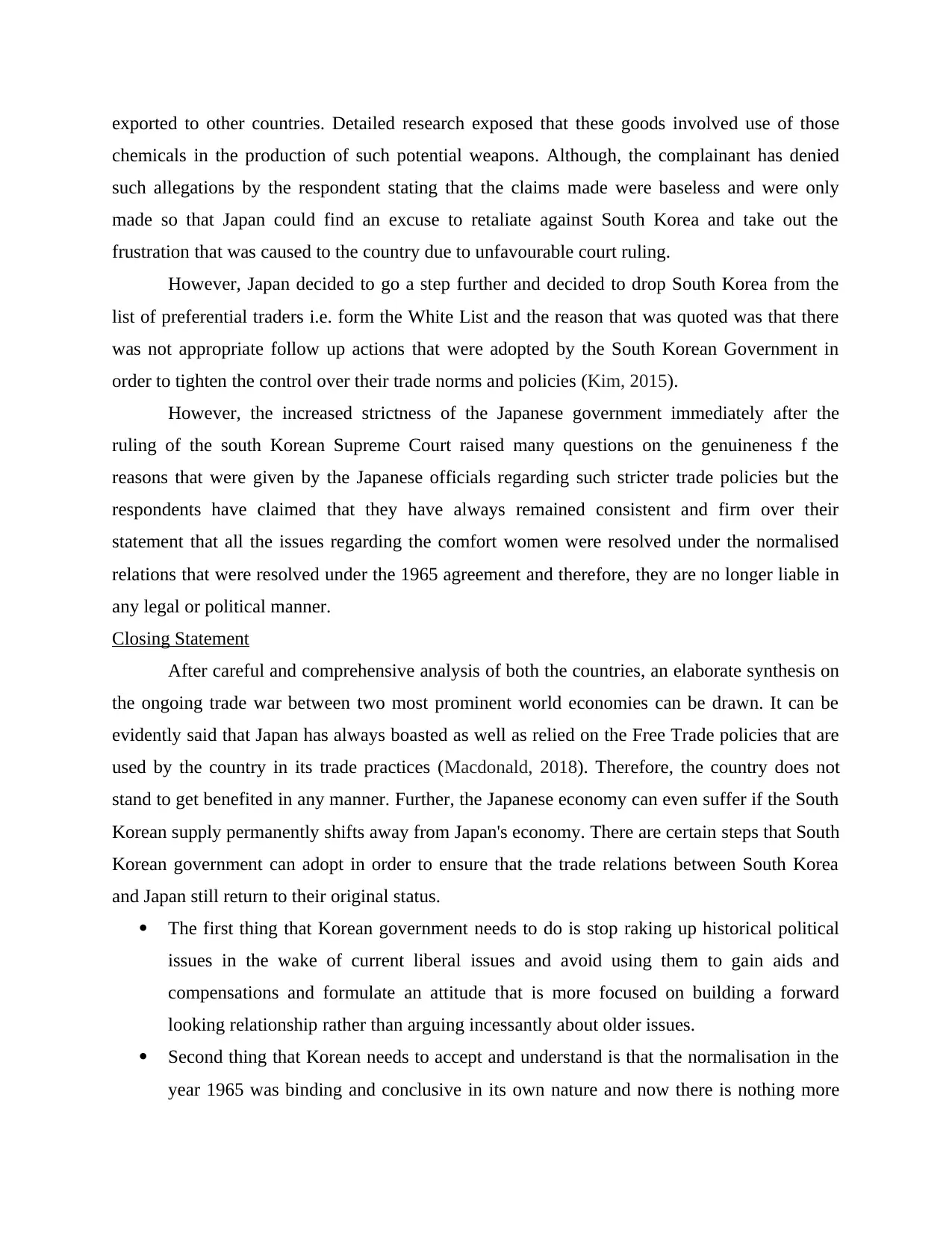
exported to other countries. Detailed research exposed that these goods involved use of those
chemicals in the production of such potential weapons. Although, the complainant has denied
such allegations by the respondent stating that the claims made were baseless and were only
made so that Japan could find an excuse to retaliate against South Korea and take out the
frustration that was caused to the country due to unfavourable court ruling.
However, Japan decided to go a step further and decided to drop South Korea from the
list of preferential traders i.e. form the White List and the reason that was quoted was that there
was not appropriate follow up actions that were adopted by the South Korean Government in
order to tighten the control over their trade norms and policies (Kim, 2015).
However, the increased strictness of the Japanese government immediately after the
ruling of the south Korean Supreme Court raised many questions on the genuineness f the
reasons that were given by the Japanese officials regarding such stricter trade policies but the
respondents have claimed that they have always remained consistent and firm over their
statement that all the issues regarding the comfort women were resolved under the normalised
relations that were resolved under the 1965 agreement and therefore, they are no longer liable in
any legal or political manner.
Closing Statement
After careful and comprehensive analysis of both the countries, an elaborate synthesis on
the ongoing trade war between two most prominent world economies can be drawn. It can be
evidently said that Japan has always boasted as well as relied on the Free Trade policies that are
used by the country in its trade practices (Macdonald, 2018). Therefore, the country does not
stand to get benefited in any manner. Further, the Japanese economy can even suffer if the South
Korean supply permanently shifts away from Japan's economy. There are certain steps that South
Korean government can adopt in order to ensure that the trade relations between South Korea
and Japan still return to their original status.
The first thing that Korean government needs to do is stop raking up historical political
issues in the wake of current liberal issues and avoid using them to gain aids and
compensations and formulate an attitude that is more focused on building a forward
looking relationship rather than arguing incessantly about older issues.
Second thing that Korean needs to accept and understand is that the normalisation in the
year 1965 was binding and conclusive in its own nature and now there is nothing more
chemicals in the production of such potential weapons. Although, the complainant has denied
such allegations by the respondent stating that the claims made were baseless and were only
made so that Japan could find an excuse to retaliate against South Korea and take out the
frustration that was caused to the country due to unfavourable court ruling.
However, Japan decided to go a step further and decided to drop South Korea from the
list of preferential traders i.e. form the White List and the reason that was quoted was that there
was not appropriate follow up actions that were adopted by the South Korean Government in
order to tighten the control over their trade norms and policies (Kim, 2015).
However, the increased strictness of the Japanese government immediately after the
ruling of the south Korean Supreme Court raised many questions on the genuineness f the
reasons that were given by the Japanese officials regarding such stricter trade policies but the
respondents have claimed that they have always remained consistent and firm over their
statement that all the issues regarding the comfort women were resolved under the normalised
relations that were resolved under the 1965 agreement and therefore, they are no longer liable in
any legal or political manner.
Closing Statement
After careful and comprehensive analysis of both the countries, an elaborate synthesis on
the ongoing trade war between two most prominent world economies can be drawn. It can be
evidently said that Japan has always boasted as well as relied on the Free Trade policies that are
used by the country in its trade practices (Macdonald, 2018). Therefore, the country does not
stand to get benefited in any manner. Further, the Japanese economy can even suffer if the South
Korean supply permanently shifts away from Japan's economy. There are certain steps that South
Korean government can adopt in order to ensure that the trade relations between South Korea
and Japan still return to their original status.
The first thing that Korean government needs to do is stop raking up historical political
issues in the wake of current liberal issues and avoid using them to gain aids and
compensations and formulate an attitude that is more focused on building a forward
looking relationship rather than arguing incessantly about older issues.
Second thing that Korean needs to accept and understand is that the normalisation in the
year 1965 was binding and conclusive in its own nature and now there is nothing more
Paraphrase This Document
Need a fresh take? Get an instant paraphrase of this document with our AI Paraphraser
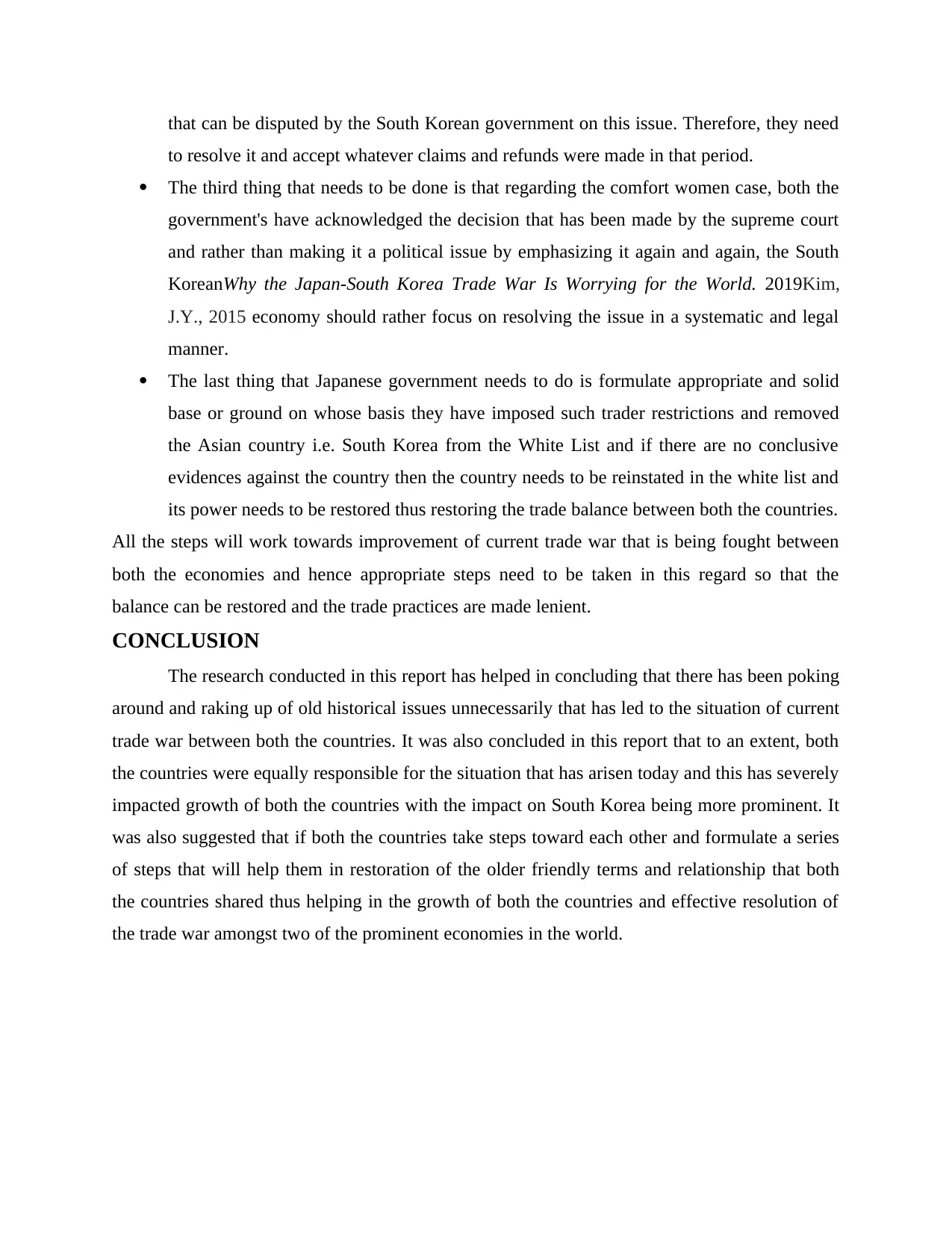
that can be disputed by the South Korean government on this issue. Therefore, they need
to resolve it and accept whatever claims and refunds were made in that period.
The third thing that needs to be done is that regarding the comfort women case, both the
government's have acknowledged the decision that has been made by the supreme court
and rather than making it a political issue by emphasizing it again and again, the South
KoreanWhy the Japan-South Korea Trade War Is Worrying for the World. 2019Kim,
J.Y., 2015 economy should rather focus on resolving the issue in a systematic and legal
manner.
The last thing that Japanese government needs to do is formulate appropriate and solid
base or ground on whose basis they have imposed such trader restrictions and removed
the Asian country i.e. South Korea from the White List and if there are no conclusive
evidences against the country then the country needs to be reinstated in the white list and
its power needs to be restored thus restoring the trade balance between both the countries.
All the steps will work towards improvement of current trade war that is being fought between
both the economies and hence appropriate steps need to be taken in this regard so that the
balance can be restored and the trade practices are made lenient.
CONCLUSION
The research conducted in this report has helped in concluding that there has been poking
around and raking up of old historical issues unnecessarily that has led to the situation of current
trade war between both the countries. It was also concluded in this report that to an extent, both
the countries were equally responsible for the situation that has arisen today and this has severely
impacted growth of both the countries with the impact on South Korea being more prominent. It
was also suggested that if both the countries take steps toward each other and formulate a series
of steps that will help them in restoration of the older friendly terms and relationship that both
the countries shared thus helping in the growth of both the countries and effective resolution of
the trade war amongst two of the prominent economies in the world.
to resolve it and accept whatever claims and refunds were made in that period.
The third thing that needs to be done is that regarding the comfort women case, both the
government's have acknowledged the decision that has been made by the supreme court
and rather than making it a political issue by emphasizing it again and again, the South
KoreanWhy the Japan-South Korea Trade War Is Worrying for the World. 2019Kim,
J.Y., 2015 economy should rather focus on resolving the issue in a systematic and legal
manner.
The last thing that Japanese government needs to do is formulate appropriate and solid
base or ground on whose basis they have imposed such trader restrictions and removed
the Asian country i.e. South Korea from the White List and if there are no conclusive
evidences against the country then the country needs to be reinstated in the white list and
its power needs to be restored thus restoring the trade balance between both the countries.
All the steps will work towards improvement of current trade war that is being fought between
both the economies and hence appropriate steps need to be taken in this regard so that the
balance can be restored and the trade practices are made lenient.
CONCLUSION
The research conducted in this report has helped in concluding that there has been poking
around and raking up of old historical issues unnecessarily that has led to the situation of current
trade war between both the countries. It was also concluded in this report that to an extent, both
the countries were equally responsible for the situation that has arisen today and this has severely
impacted growth of both the countries with the impact on South Korea being more prominent. It
was also suggested that if both the countries take steps toward each other and formulate a series
of steps that will help them in restoration of the older friendly terms and relationship that both
the countries shared thus helping in the growth of both the countries and effective resolution of
the trade war amongst two of the prominent economies in the world.
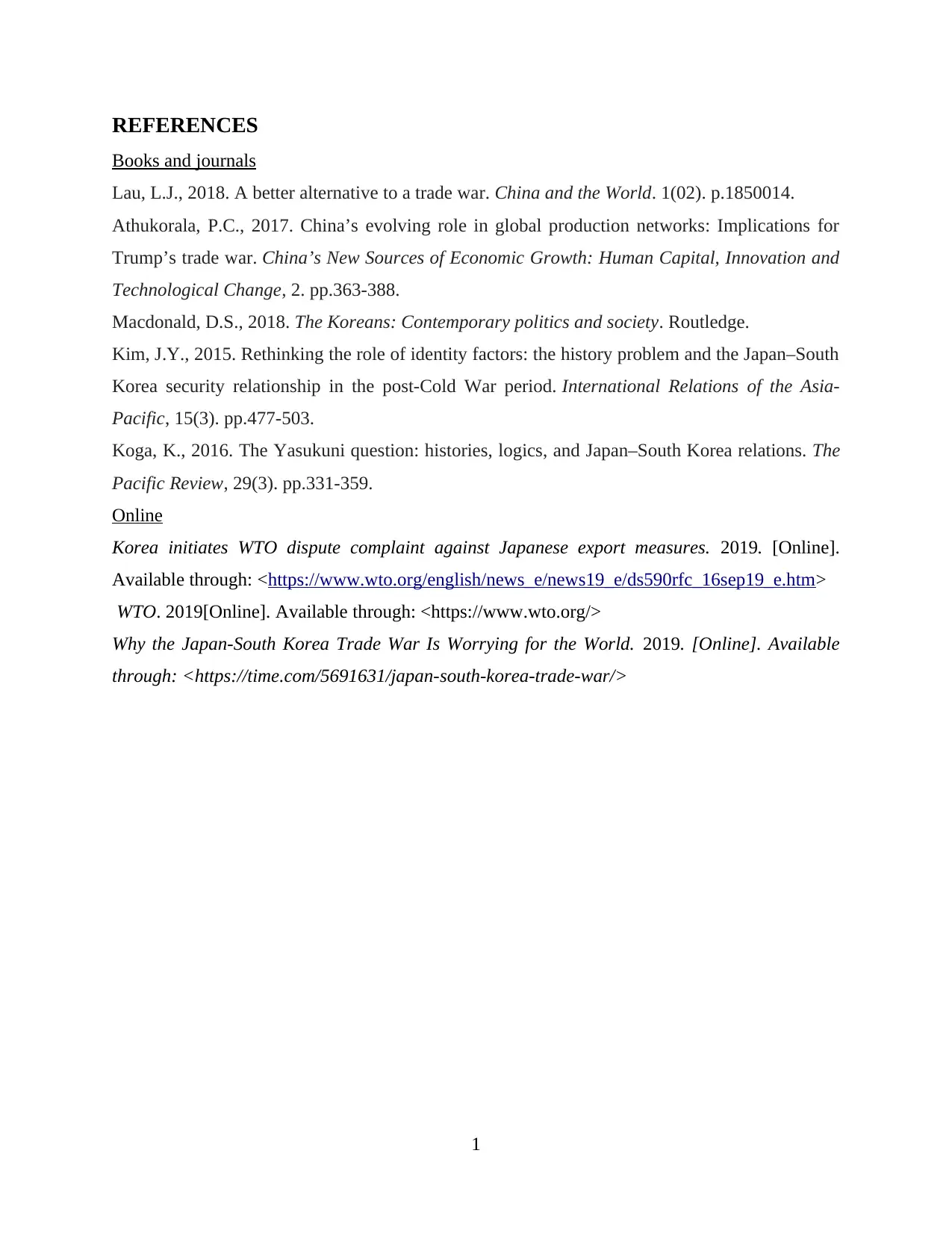
REFERENCES
Books and journals
Lau, L.J., 2018. A better alternative to a trade war. China and the World. 1(02). p.1850014.
Athukorala, P.C., 2017. China’s evolving role in global production networks: Implications for
Trump’s trade war. China’s New Sources of Economic Growth: Human Capital, Innovation and
Technological Change, 2. pp.363-388.
Macdonald, D.S., 2018. The Koreans: Contemporary politics and society. Routledge.
Kim, J.Y., 2015. Rethinking the role of identity factors: the history problem and the Japan–South
Korea security relationship in the post-Cold War period. International Relations of the Asia-
Pacific, 15(3). pp.477-503.
Koga, K., 2016. The Yasukuni question: histories, logics, and Japan–South Korea relations. The
Pacific Review, 29(3). pp.331-359.
Online
Korea initiates WTO dispute complaint against Japanese export measures. 2019. [Online].
Available through: <https://www.wto.org/english/news_e/news19_e/ds590rfc_16sep19_e.htm>
WTO. 2019[Online]. Available through: <https://www.wto.org/>
Why the Japan-South Korea Trade War Is Worrying for the World. 2019. [Online]. Available
through: <https://time.com/5691631/japan-south-korea-trade-war/>
1
Books and journals
Lau, L.J., 2018. A better alternative to a trade war. China and the World. 1(02). p.1850014.
Athukorala, P.C., 2017. China’s evolving role in global production networks: Implications for
Trump’s trade war. China’s New Sources of Economic Growth: Human Capital, Innovation and
Technological Change, 2. pp.363-388.
Macdonald, D.S., 2018. The Koreans: Contemporary politics and society. Routledge.
Kim, J.Y., 2015. Rethinking the role of identity factors: the history problem and the Japan–South
Korea security relationship in the post-Cold War period. International Relations of the Asia-
Pacific, 15(3). pp.477-503.
Koga, K., 2016. The Yasukuni question: histories, logics, and Japan–South Korea relations. The
Pacific Review, 29(3). pp.331-359.
Online
Korea initiates WTO dispute complaint against Japanese export measures. 2019. [Online].
Available through: <https://www.wto.org/english/news_e/news19_e/ds590rfc_16sep19_e.htm>
WTO. 2019[Online]. Available through: <https://www.wto.org/>
Why the Japan-South Korea Trade War Is Worrying for the World. 2019. [Online]. Available
through: <https://time.com/5691631/japan-south-korea-trade-war/>
1
⊘ This is a preview!⊘
Do you want full access?
Subscribe today to unlock all pages.

Trusted by 1+ million students worldwide

2
1 out of 10
Related Documents
Your All-in-One AI-Powered Toolkit for Academic Success.
+13062052269
info@desklib.com
Available 24*7 on WhatsApp / Email
![[object Object]](/_next/static/media/star-bottom.7253800d.svg)
Unlock your academic potential
Copyright © 2020–2025 A2Z Services. All Rights Reserved. Developed and managed by ZUCOL.





